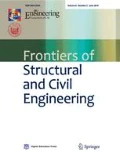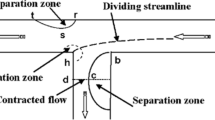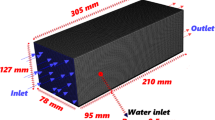Abstract
We investigate the performance of a novel vertical slot fishway by employing finite volume and surrogate models. Multiple linear regression, multiple log equation regression, gene expression programming, and combinations of these models are employed to predict the maximum turbulence, maximum velocity, resting area, and water depth of the middle pool in the fishway. The statistical parameters and error terms, including the coefficient of determination, root mean square error, normalized square error, maximum positive and negative errors, and mean absolute percentage error were employed to evaluate and compare the accuracy of the models. We also conducted a parametric study. The independent variables include the opening between baffles (OBB), the ratio of the length of the large and small baffles, the volume flow rate, and the angle of the large baffle. The results show that the key parameters of the maximum turbulence and velocity are the volume flow rate and OBB.
Similar content being viewed by others
References
Fao D V W K. Fish Passes: Design, Dimensions, and Monitoring. Rome: Food and Agriculture Organization of the United Nations, 2002
Katopodis C, Williams J G. The development of fish passage research in a historical context. Ecological Engineering, 2012, 48: 8–18
Rajaratnam N, Van der Vinne G, Katopodis C. Hydraulics of vertical slot fishways. Journal of Hydraulic Engineering, 1986, 112(10): 909–927
Rajaratnam N, Katopodis C, Solanki S. New designs for vertical slot fishways. Canadian Journal of Civil Engineering, 1992, 19(3): 402–414
Cea L, Pena L, Puertas J, Vázquez-Cendón M E, Peña E. Application of several depth-averaged turbulence models to simulate flow in vertical slot fishways. Journal of Hydraulic Engineering, 2007, 133(2): 160–172
Bermúdez M, Puertas J, Cea L, Pena L, Balairón L. Influence of pool geometry on the biological efficiency of vertical slot fishways. Ecological Engineering, 2010, 36(10): 1355–1364
Marriner B A, Baki A B M, Zhu D Z, Thiem J D, Cooke S J, Katopodis C. Field and numerical assessment of turning pool hydraulics in a vertical slot fishway. Ecological Engineering, 2014, 63: 88–101
Katopodis C. Introduction to Fishway Design. Winnipeg: Freshwater Institute, 1992
Liu M, Rajaratnam N, Zhu D Z. Mean flow and turbulence structure in vertical slot fishways. Journal of Hydraulic Engineering, 2006, 132(8): 765–777
Chorda J, Maubourguet M M, Roux H, Larinier M, Tarrade L, David L. Two-dimensional free surface flow numerical model for vertical slot fishways. Journal of Hydraulic Research, 2010, 48(2): 141–151
Tarrade L, Texier A, David L, Larinier M. Topologies and measurements of turbulent flow in vertical slot fishways. Hydro-biology, 2008, 609(1): 177–188
Tarrade L, Pineau G, Calluaud D, Texier A, David L, Larinier M. Detailed experimental study of hydrodynamic turbulent flows generated in vertical slot fishways. Environmental Fluid Mechanics, 2011, 11(1): 1–21
Bombač M, Novak G, Rodič P, Četina M. Numerical and physical model study of a vertical slot fishway. Journal of Hydrology and Hydromechanics, 2014, 62(2): 150–159
Bombač M, Novak G, Mlačnik J, Četina M. Extensive field measurements of flow in vertical slot fishway as data for validation of numerical simulations. Ecological Engineering, 2015, 84: 476–484
Larinier M, Travade F, Porcher J P. Fishways: Biological basis, design criteria and monitoring. Bulletin Francais de la Peche et de la Pisciculture, 2002, 364: 1–208
Fuentes-Pérez J F, Silva A T, Tuhtan J A, García-Vega A, Carbonell-Baeza R, Musall M, Kruusmaa M. 3D modelling of non-uniform and turbulent flow in vertical slot fishways. Environmental Modelling & Software, 2018, 99: 156–169
Fuentes-Pérez J F, Eckert M, Tuhtan J A, Ferreira M T, Kruusmaa M, Branco P. Spatial preferences of Iberian barbel in a vertical slot fishway under variable hydrodynamic scenarios. Ecological Engineering, 2018, 125: 131–142
Li G, Sun S, Zhang C, Liu H, Zheng T. Evaluation of flow patterns in vertical slot fishways with different slot positions based on a comparison passage experiment for juvenile grass carp. Ecological Engineering, 2019, 133: 148–159
Wu S, Rajaratnam N, Katopodis C. Structure of flow in vertical slot fishway. Journal of Hydraulic Engineering, 1999, 125(4): 351–360
Rodríguez T T, Agudo J P, Mosquera L P, González E P. Evaluating vertical-slot fishway designs in terms of fish swimming capabilities. Ecological Engineering, 2006, 27(1): 37–48
Wang R W, David L, Larinier M. Contribution of experimental fluid mechanics to the design of vertical slot fish passes. Knowledge and Management of Aquatic Ecosystems, 2010, 2(396): 78–83
Fuentes-Pérez J F, Sanz-Ronda F J, Martínez de Azagra Paredes A, García-Vega A. Modeling water-depth distribution in vertical-slot fishways under uniform and nonuniform scenarios. Journal of Hydraulic Engineering, 2014, 140(10): 06014016
Marriner B A, Baki A B, Zhu D Z, Cooke S J, Katopodis C. The hydraulics of a vertical slot fishway: A case study on the multi-species Vianney-Legendre fishway in Quebec, Canada. Ecological Engineering, 2016, 90: 190–202
Lepper P. Manual on the Methodological Framework to Derive Environmental Quality Standards for Priority Substances in Accordance with Article 16 of the Water Framework Directive (2000/60/EC). Schmallenberg: Fraunhofer-Institute Molecular Biology and Applied Ecology, 2005
Ciuha D, Povž M, Kvaternik K, Brenčič M, Muck P. The design and technical solutions of passages for aquatic organisms at the HPP on the lower Sava River reach, with an emphasis on the passage at HPP Arto—Blanca. In: Proceedings of the Mišicev Vodarski Dan. Maribor, Slovenia, 2014, 228–236 (in Slovenian)
Kolman G, Mikoš M, Povž M. Fish passages on hydroelectric power dams in Slovenia. Nature conservation, 2010, 24: 85–96
Maddock I, Harby A, Kemp P, Wood P J. Ecohydraulics: An integrated approach. Worcester: John Wiley & Sons, 2013
Calluaud D, Pineau G, Texier A, David L. Modification of vertical slot fishway flow with a supplementary cylinder. Journal of Hydraulic Research, 2014, 52(5): 614–629
Goodwin R, Anderson J, Nestler J. Decoding 3-D movement patternsof fish in response to hydrodynamics and water quality for forecast simulation. In: Proceedings of the 6th International Conference in Hydroinformatics. Singapore: World scientific, 2004
Rodriguez Á, Bermúdez M, Rabuñal J R, Puertas J, Dorado J, Pena L, Balairón L. Optical fish trajectory measurement in fishways through computer vision and artificial neural networks. Journal of Computing in Civil Engineering, 2011, 25(4): 291–301
Duguay J M, Lacey R W J, Gaucher J. A case study of a pool and weir fishway modeled with OpenFOAM and FLOW-3D. Ecological Engineering, 2017, 103: 31–42
Puertas J, Pena L, Teijeiro T. Experimental approach to the hydraulics of vertical slot fishways. Journal of Hydraulic Engineering, 2004, 130(1): 10–23
Clay C H. Design of Fishways and Other Fish Facilities. 2nd ed. Ottawa: Department of Fisheries of Canada, 1995
Bell M C. Fisheries Handbook of Engineering Requirements and Biological Criteria. Portland, OR: Fisheries Engineering Research Program, 1973
Shiri J, Sadraddini A A, Nazemi A H, Kisi O, Landeras G, Fakheri Fard A, Marti P. Generalizability of Gene Expression Programming-based approaches for estimating daily reference evapotranspiration in coastal stations of Iran. Journal of Hydrology (Amsterdam), 2014, 508: 1–11
Traore S, Guven A. New algebraic formulations of evapotranspiration extracted from gene-expression programming in the tropical seasonally dry regions of West Africa. Irrigation Science, 2013, 31(1): 1–10
Azamathulla H M, Yusoff M A M. Soft computing for prediction of river pipeline scour depth. Neural Computing & Applications, 2013, 23(7–8): 2465–2469
Azamathulla H M, Ahmad Z, Ab. Ghani A. An expert system for predicting Manning’s roughness coefficient in open channels by using gene expression programming. Neural Computing & Applications, 2013, 23(5): 1343–1349
Guven A, Aytek A. New approach for stage–discharge relationship: gene-expression programming. Journal of Hydrologic Engineering, 2009, 14(8): 812–820
Azamathulla H M. Gene expression programming for prediction of scour depth downstream of sills. Journal of Hydrology (Amsterdam), 2012, 460–461: 156–159
Kumar A, Goyal P. Forecasting of air quality in Delhi using principal component regression technique. Atmospheric Pollution Research, 2011, 2(4): 436–444
Shishegaran A, Amiri A, Jafari M A. Seismic performance of boxplate, box-plate with UNP, box-plate with L-plate and ordinary rigid beam-to-column moment connections. Journal of Vibroengineering, 2018, 20(3): 1470–1487
Chenini I, Khemiri S. Evaluation of ground water quality using multiple linear regression and structural equation modeling. International Journal of Environmental Science and Technology, 2009, 6(3): 509–519
Chen W B, Liu W C. Water quality modeling in reservoirs using multivariate linear regression and two neural network models. Advances in Artificial Neural Systems, 2015, 2015: 1–6
Nasir M F M, Samsudin M S, Mohamad I, Awaluddin M R A, Mansor M A, Juahir H, Ramli N. River water quality modeling using combined principle component analysis (PCA) and multiple linear regressions (MLR): A case study at Klang River, Malaysia. World Applied Sciences Journal, 2011, 14: 73–82
An R, Li J, Liang R, Tuo Y. Three-dimensional simulation and experimental study for optimising a vertical slot fishway. Journal of Hydro-environment Research, 2016, 12: 119–129
Hirt C, Nichols B. Volume of fluid (VOF) method for the dynamics of free boundaries. Journal of Computational Physics, 1981, 39(1): 201–225
Prosperetti A, Tryggvason G. Computational Methods for Multiphase Flow. Cambridge: Cambridge University, 2007
Oertel M, Bung D B. Initial stage of two-dimensional dam-break waves: laboratory versus VOF. Journal of Hydraulic Research, 2012, 50(1): 89–97
Hirsch C. Numerical Computation of Internal and External Flows: The Fundamentals of Computational Fluid Dynamics. Burlington: Elsevier, 2007
Bayon A, Valero D, García-Bartual R, Vallés-Morán F J, López-Jiménez P A. Performance assessment of OpenFOAM and FLOW-3D in the numerical modeling of a low Reynolds number hydraulic jump. Environmental Modelling & Software, 2016, 80: 322–335
Keyes D, Ecer A, Satofuka N, Fox P, Periaux J. Parallel Computational Fluid Dynamics’ 99: Towards Teraflops, Optimization and Novel Formulations. Amsterdam: Elsevier, 2000
Chen L, Li Y. A numerical method for two-phase flows with an interface. Environmental Modelling & Software, 1998, 13(3–4): 247–255
Hyman J M. Numerical methods for tracking interfaces. Physica D. Nonlinear Phenomena, 1984, 12(1–3): 396–407
Bayon-Barrachina A, Lopez-Jimenez P A. Numerical analysis of hydraulic jumps using OpenFOAM. Journal of Hydroinformatics, 2015, 17(4): 662–678
Ubbink O. Numerical prediction of two fluid systems with sharp interfaces. Dissertation for the Doctoral Degree. London: University of London and Diploma of Imperial College, 1997
Bung D, Schlenkhoff A. Self-aerated skimming flow on embankment stepped spillways: The effect of additional micro-roughness on energy dissipation and oxygen transfer. In: Proceedings from first IAHR European congress: May 2010, Edinburgh. Edinburgh: Heriot-Watt University, 2010
Pfister M. Chute aerators: Steep deflectors and cavity subpressure. Journal of Hydraulic Engineering, 2011, 137(10): 1208–1215
Chanson H. Hydraulics of aerated flows: Qui pro quo? Journal of Hydraulic Research, 2013, 51(3): 223–243
Lobosco R J, Schulz H E, Simões A L A. Hydrodynamics-Optimizing Methods and Tools. Sao Paulo, 2011, 1–25
Tøge G E. The significance of Froude number in vertical pipes: A CFD study. Thesis for the Master’s Degree. Norway: University of Stavanger, 2012
Valero D, Bung D B. Hybrid investigations of air transport processes in moderately sloped stepped spillway flows. In: E-Proceedings of the 36th IAHR World Congress. The Hague, the Netherlands, 1–10
Ma J, Oberai A A, Lahey R T, Drew D A. Modeling air entrainment and transport in a hydraulic jump using two-fluid RANS and DES turbulence models. Heat and Mass Transfer, 2011, 47(8): 911–919
Valero D, García-Bartual R. Calibration of an air entrainment model for CFD spillway applications. In: Advances in hydroinformatics. Singapore: Springer, 2016, 571–582
Kim J J, Baik J J. A numerical study of the effects of ambient wind direction on flow and dispersion in urban street canyons using the RNG k–ε turbulence model. Atmospheric Environment, 2004, 38(19): 3039–3048
Bombardelli F A, Meireles I, Matos J. Laboratory measurements and multi-block numerical simulations of the mean flow and turbulence in the non-aerated skimming flow region of steep stepped spillways. Environmental Fluid Mechanics, 2011, 11(3): 263–288
Xu T, Jin Y C. Numerical investigation of flow in pool-and-weir fishways using a meshless particle method. Journal of hydraulic research, 2014, 52(6): 849–861
Quaranta E, Katopodis C, Revelli R, Comoglio C. Turbulent flow field comparison and related suitability for fish passage of a standard and a simplified low-gradient vertical slot fishway. River Research and Applications, 2017, 33(8): 1295–1305
Guiny E, Ervine D, Armstrong J. Hydraulic and biological aspects of fish passes for Atlantic salmon. Journal of Hydraulic Engineering, 2005, 131(7): 542–553
Morrison R R, Hotchkiss R H, Stone M, Thurman D, Horner-Devine A R. Turbulence characteristics of flow in a spiral corrugated culvert fitted with baffles and implications for fish passage. Ecological Engineering, 2009, 35(3): 381–392
Silva A T, Santos J M, Ferreira M T, Pinheiro A N, Katopodis C. Effects of water velocity and turbulence on the behaviour of Iberian barbel (Luciobarbus bocagei, Steindachner 1864) in an experimental pool-type fishway. River Research and Applications, 2011, 27(3): 360–373
Hamdia K M, Rabczuk T. Fracture, Fatigue and Wear. Singapore: Springer, 2018
Badawy M F, Msekh M A, Hamdia K M, Steiner M K, Lahmer T, Rabczuk T. Hybrid nonlinear surrogate models for fracture behavior of polymeric nanocomposites. Probabilistic Engineering Mechanics, 2017, 50: 64–75
Nguyen V P, Lian H, Rabczuk T, Bordas S. Modelling hydraulic fractures in porous media using flow cohesive interface elements. Engineering Geology, 2017, 225: 68–82
Rabczuk T, Gracie R, Song J H, Belytschko T. Immersed particle method for fluid-structure interaction. International Journal for Numerical Methods in Engineering, 2010, 81(1): 48–71
Wall W A, Rabczuk T. Fluid-structure interaction in lower airways of CT-based lung geometries. International Journal for Numerical Methods in Fluids, 2008, 57(5): 653–675
Rabczuk T, Samaniego E, Belytschko T. Simplified model for predicting impulsive loads on submerged structures to account for fluid-structure interaction. International Journal of Impact Engineering, 2007, 34(2): 163–177
Nguyen-Thoi T, Phung-Van P, Rabczuk T, Nguyen-Xuan H, LeVan C. An application of the ES-FEM in solid domain for dynamic analysis of 2D fluid-solid interaction problems. International Journal of Computational Methods, 2013, 10(1): 1340003
Najafi B, Faizollahzadeh Ardabili S, Shamshirband S, Chau K W, Rabczuk T. Application of ANNs, ANFIS and RSM to estimating and optimizing the parameters that affect the yield and cost of biodiesel production. Engineering Applications of Computational Fluid Mechanics, 2018, 12(1): 611–624
Zhou S, Zhuang X, Rabczuk T. Phase-field modeling of fluid-driven dynamic cracking in porous media. Computer Methods in Applied Mechanics and Engineering, 2019, 350: 169–198
Ferreira C. Soft Computing and Industry. London: Springer, 2002, 635–653
Bates J M, Granger C W. The combination of forecasts. Journal of the Operational Research Society, 1969, 20(4): 451–468
Takezawa K. A revision of AIC for normal error models. Open Journal of Statistics, 2012, 2(3): 309–312
Author information
Authors and Affiliations
Corresponding author
Rights and permissions
About this article
Cite this article
Shishegaran, A., Shokrollahi, M., Mirnorollahi, A. et al. A novel ensemble model for predicting the performance of a novel vertical slot fishway. Front. Struct. Civ. Eng. 14, 1418–1444 (2020). https://doi.org/10.1007/s11709-020-0664-x
Received:
Accepted:
Published:
Issue Date:
DOI: https://doi.org/10.1007/s11709-020-0664-x




